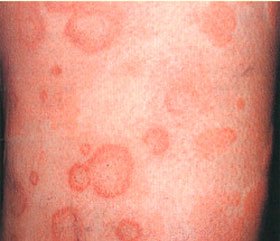Журнал «Здоровье ребенка» (62) 2015. Тематический выпуск "Детская гастроэнтерология"
Вернуться к номеру
Eosinophilic esophagitis is one of the manifestations of gastrointestinal food allergy in children
Авторы: Nyankovskyy S.L., Horodylovska M.I., Ivantsiv V.A., Boyko О.I. — Danylo Halytskyy Lviv National Medical University, Ukraine
Рубрики: Педиатрия/Неонатология
Разделы: Клинические исследования
Версия для печати
Gastrointestinal allergy is an integral part of food allergy (FA). It is the defeat of the gastrointestinal tract (GIT) due to the immune response to food components with clinical manifestations of allergic reactions on the part of the digestive system and possible damage to various departments throughout GIT.
Gastrointestinal manifestations of FA are quite varied and depend on the type and dose of allergen, the patient's age, level and depth of the lesion gastrointestinal tract. Morphological base of the clinical picture in most cases is immune inflammation with eosinophilic infiltration of tissues in the absence of other causes for tissue eosinophilia. Eosinophilic gastrointestinal lesions include immediate gastrointestinal hypersensitivity, oral allergy syndrome, eosinophilic esophagitis, eosinophilic gastritis, eosinophilic gastroenteritis, eosinophilic gastroenterocolitis.
Eosinophilic esophagitis (EoE) is characterized by severe isolated eosinophilic infiltration of the esophagus, clinically manifested symptoms are similar in patients with gastroesophageal reflux disease (GERD) in children and adults.
EoE is not responsible to intense antisecretory therapy, but its symptoms usually disappear when you turn off specific food allergens. Symptoms of EoE which worsen the quality of life of patients are the dysphagia, acute obstruction of the esophagus, shortness of breath, panic.
Objective: to improve the diagnosis and the efficasy of treatment of eosinophilic esophagitis in children of school age by determining the role of food allergy in their origin and use of complex antiallergic treatment.
Materials and methods. We observed 63 children aged 6-17 years who were treated in the Department of Pediatric Gastroenterology in Lviv City Children's Hospital. All children were performed to endoscopic fibroezophahohastrodudenoskopy (FEHDS), during which in cases of suspected EoE biopsy material was taken from the mucosa of proximal, middle and distal esophagus to verify the diagnosis.
After morphological study the diagnosis of EoE was confirmed in 40 children (29 of them were boys (72.5%) and 11 (27.5%) the girls). In other cases peptic reflux esophagitis was confirmed. Children with verified diagnosis of EoE were divided into 2 groups.
The main group consisted of 20 children who were appointed elimination or hypoallergenic diet (depending on the results of skin allergy tests), levocetirizine and probiotic bacteria L. reuteri. The control group consisted of 20 children who received elimination and hypoallergenic diet (depending on the results of skin allergy tests) and levocetirizine. The course of treatment lasted for 1 month, after that second FEHDS with biopsy was done to determine the efficasy of the treatment.
Results and discussion. The main complaints of children during the initial survey were decreased appetite (75% of both groups), heartburn (65% of children of the main and 60% of the control group), recurrent regurgitation (50% and 45% respectively), epigastric pain of varying intensity (75 % and 70% respectively), vomiting (25% and 30% respectively) and dysphagia (20% and 10% respectively).
An objective examination of 100% of both groups experienced pain on palpation in the epigastric region.
Verification of EoE was based on morphological studies of esophageal biopsy samples. The main hallmarks for confirmation of diagnosis were 15 eosinophils in the field of high definition microscope (h400) and the presence of eosinophilic microabscesses.
After the treatment we received the improvement of clinical, endoscopic and morphological parameters in both groups (Table 1).
Multiple whitish raid which were found in primary endoscopy completely regressed in 75% of children in the main group and in 55% of children in the control group, 25% and 45% of children, respectively - in part .
Number of eosinophils in the esophagus biopsy decreased in the two groups, particularly in the study group it was 4,7 ± 1,56 eosinophils/high-power field vs 18,4 ± 3,267 eosinophils in eosinophils/high-power field at baseline and in the control group 9,95 ± 2,09 eosinophils in eosinophils/high-power field vs 17,8 ± 2,19 eosinophils/high-power field respectively. Significantly better dynamic was observed in children of the main group (p <0.05). There were not eosinophilic degranulation and eosinophilic microabscesses in esophageal biopsy samples of both groups after one month of treatment. But hyperplasia of the basal layer of the epithelium was in 10% of biopsies of children in the main group and 15% of biopsies of children in the control group, intercellular edema - 10% and 20% respectively .
Table 1
Endoscopic and morphological parameters of esophageal mucosa in children of both groups
* Note - the probability of differences between the main and control group in the second study (p <0.05).
Conclusions. Eosinophilic esophagitis takes prominent place in the structure of gastrointestinal manifestations of food allergy. Diagnosis of this disease must include endoscopic examination with taking biopsy, followed by its morphological verification. The inclusion of probiotic L. reuteri into the complex therapy of eosinophilic esophagitis significantly affect the outcomes of children – there was better reduction of clinical symptoms and significant decrease in the number of eosinophils in the esophagus of children.


/0117.jpg)